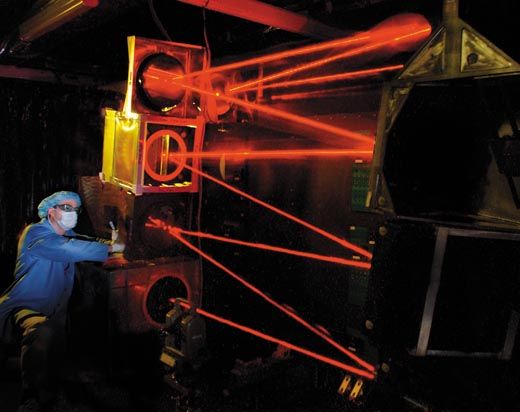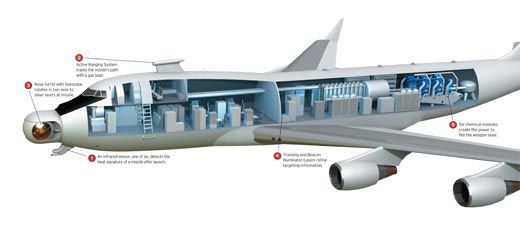How Things Work: Missile Killer
In this tables-turned scenario, the airplane shoots down the missile.
/https://tf-cmsv2-smithsonianmag-media.s3.amazonaws.com/filer/How%20Things%20Work%20Missile%20Killer%20FL.jpg)
Last February, off the California coast, military aerospace achieved a first: an airplane fired a laser, destroying a missile shortly after it had been launched. Here’s how.
The laser is one of several being developed by Boeing, Lockheed Martin, and Northrop Grumman. While some lasers are being designed to attack battlefield targets at close range, this high-energy, megawatt, chemical laser on board a modified Boeing 747-400F is specifically designed to destroy all classes of ballistic missiles during the first few minutes after launch.
Though the technology appears to work, its huge cost will clip the Airborne Laser’s wings. Last spring, Secretary of Defense Robert Gates cancelled a second test aircraft and eliminated plans to deploy operational Airborne Lasers. He is allowing the test program to continue with the remaining 747, now called the Airborne Laser Testbed, because it is contributing to a broader understanding of directed-energy weapons.
In combat, the airplane would orbit at about 40,000 feet near the front lines of a battle or as close to enemy missile sites as possible. Six infrared sensors on the airplane’s fuselage would detect a missile as it climbed above 40,000 feet at a range of up to “a few hundred kilometers,” says Mike Rinn, Airborne Laser program director for lead contractor Boeing (a kilometer is .62 mile). Like many details about the weapon, the exact range is classified.
Atop the fuselage, the Active Ranging System, a modified electronic targeting pod like those used by fighter airplanes, would acquire the missile and track it with a high-power gas laser to determine its launch and impact points. An onboard computer system would identify and classify the missile as an enemy target. Then, inside a bulbous turret in the 747’s nose, a telescope with a 50-inch-diameter mirror would turn toward the missile.
Next, a Tracking Illuminator Laser would fire four narrow beams at the target, and the telescope would detect their reflection, refining the distance and direction to the missile.
A Beacon Illuminator Laser would then fire four more beams to measure distortions created as these beams passed through air masses of different temperatures and densities, which bend light in different directions. Once the distortions were measured, the system would compensate for them by reshaping small mirrors hundreds of times per second. This would be accomplished by hundreds of tiny electric actuators, or pistons, similar to the adaptive optics used in ground-based astronomical telescopes. Reshaping the mirrors allows them to reflect the final, high-power, weapon laser in a way that focuses its energy to counteract the atmospheric effects, and aims the narrowest possible beam at the target.
The weapon is a Chemical Oxygen Iodine Laser, which uses a combination of hydrogen peroxide, potassium, sodium, and lithium hydroxide (“Think Drano,” Rinn says). In the back of the 747, the chilled laser fuel would be sprayed through a grid of pores like a showerhead, and passed through a mixture of chlorine and helium to produce a form of oxygen. The oxygen is then injected with iodine gas, which excites it and produces photons that are intensified to create the infrared laser beam, which exits the nose turret. The challenge is to create enough energy for the beam to maintain strength and duration over the distance to a target missile. In a few seconds, the beam heats the missile enough to rupture its fuel tanks and destroy it.
“The system is extremely capable,” says Rinn. “As we tune it and increase the power and decrease the jitter and make the [atmospheric] control even better, the range will go up.” He adds that studies by Boeing show that the weapon could also shoot down aircraft, surface-to-air missiles, drones, and other targets.
With more successes, might the Pentagon reconsider and fund an operational system? Practical limitations would almost surely prevent it, according to Barry Watts, a senior fellow at the Center for Strategic and Budgetary Assessments. “If you want to maintain a 24-hour orbit, how many airplanes would you need?” he asks. “The answer is probably three or four.” And that’s just for one area of interest—the Airborne Laser was never intended for global use. “You’d probably get pretty good coverage off the east coast of North Korea, for example,” he says. “Then there’s the issue of having the intelligence beforehand to position the orbit in the right place so you can actually do something against boost-phase missiles. Gates’ position was that we’re not going to buy a large enough fleet of these things to be able to fulfill realistic operational requirements.”
Watts could see a high-energy chemical laser on the ground. “Israel has a small area to defend,” he says. “They could hook [a big chemical] laser up to a ground-based industrial system. That makes a lot of sense for their problems. For the U.S., with so much more territory to defend, that would get expensive fast.” One day, the laser may be able to reach targets far higher than boost-phase missiles. “You could put a big one on the ground and mess with people’s satellites,” says Watts. Airborne or not, it looks like lasers have arrived.
Damond Benningfield is a science and technology writer in Austin, Texas.

